
.
If you have any comments, observations, or questions about what you read here, remember you can always Contact Me
All content included on this site such as text, graphics and images is protected by U.S and international copyright law.
The compilation of all content on this site is the exclusive property of the site copyright holder.
As we were driving back from Roseberry Homestead on Friday evening Bill said "There's another event on Sunday. Ramsayburg is about 45 minutes upriver. They have a smokehouse and it will be in operation." He knows how to attract my attention. So just shortly after noon we were off for another visit to yet another 18th century homestead.

A late 18th century Georgian style wood-frame structure, the house was used as a tavern for rafters traveling on the Delaware River. James and Adam Ramsay, Irish immigrants, acquired the fifty-acre tract (which already included a tavern) along the Delaware River in what was then New Jersey's northwestern frontier in 1794 or 1795. They continued to operate the tavern and established a store, around which a hamlet grew. The homestead's special significance is for its association with the timber rafting trade.

Today the Ramsayburg homestead consists of a house and several outbuildings on an approximately 12-acre site.
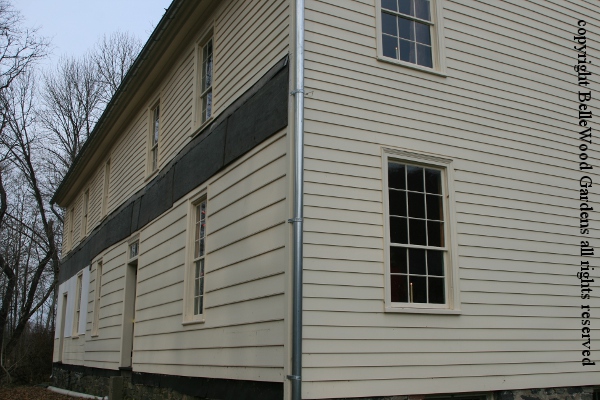
The frame two-story house, a notable example of the region's early domestic architecture, retains many late 18th-, early 19th-century features, such as beaded clapboards which were, of course, included in the exterior restoration.

.
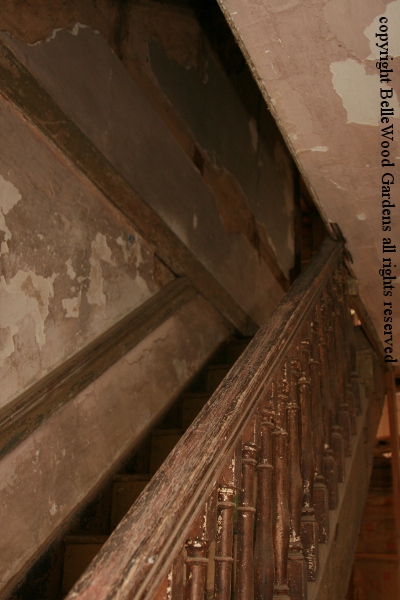
The exterior of the house has been well restored. The interior, alas, is disintegrating. Floors are buckling, plastered walls falling apart (ceilings too), and staircases are completely unsafe. A wreath or two adorned a door and a wall. Otherwise the yellow police tape to keep visitors from falling down stairs, out a back door with no steps, and away from other hazards meant the interior was not especially inviting. I understand keeping a portion of a wall's structure exposed (as at the Hoff Vannata farmstead so we can see the structural details. This situation is just a sad case of falling apart. Extension cords strung here and there powered the few lights and an electric keyboard piano. The Knowlton elementary school band was tuning up for their Christmas performance while parents, siblings, and perhaps additional relatives stayed outdoors on the veranda.

Described as a Christmas celebration the event was instead a fund raiser. The refreshments did include mulled hot cider, hot chocolate, soups, and more, but only for sale. A modest holiday market offered gift-boxed home-made cookies, hand-crafted ornaments, and wreaths.

.
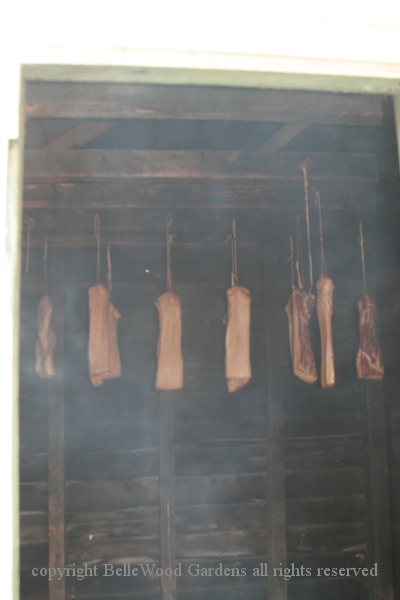
Bill and I walked down to the smokehouse where slabs of bacon were veiled in fragrant applewood smoke. The event description did mention that there would be a smokehouse demonstration by Myron Baley, providing custom-cured bacon for holiday gift-giving. He and I had a pleasant conversation about curing bacon. He uses brown sugar or molasses or sorghum or honey, but not maple syrup. This batch is with honey.
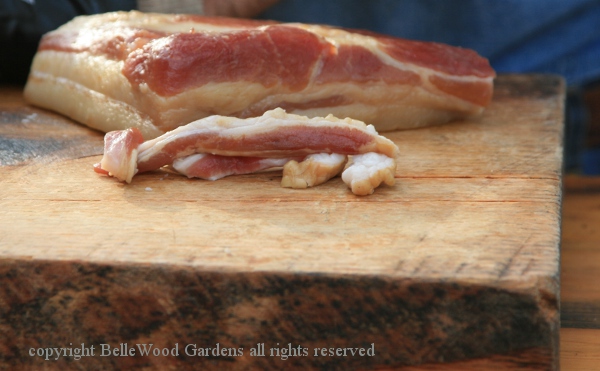
I've not tried honey when I make bacon. Bill bought a little package of bacon, sliced on the spot. I bought a piece, about a pound and a half, we agreed.
And then the two of us left, to see what else of interest could be found in the general area.

We went to a cemetery in the Columbia section of Knowlton Township in Warren County, New Jersey. But not to look at the tombstones. We were looking at the Fairview Schoolhouse. Built in 1835 the Octagon schoolhouse was listed on the National Register of Historic Places nearly 40 years ago. Even the chimney is octagonal. The exterior appears to be concrete. Bill thought it was supposed to be stone block. So either A) it has been sort of stucco-ed over with concrete or B) when it was replaced with a new schoolhouse in 1897 it was redone in concrete. No idea. It currently serves as a tool shed for the cemetery workers.

And back at the edge of the woods is a traditional outhouse.
We didn't investigate if it was still operational.
I'd read something about a viaduct. Which Bill said was not too far out of the way. So it was added onto today's list of "what to see."

Oh. My. Goodness.
The Paulinskill viaduct, also known as the Hainesburg trestle, is a long abandoned railroad bridge over the Paulinskill River near Blairstown. When first constructed (entirely with reinforced concrete) it was considered to be one of the wonders of the world. The seven arch span is an astounding 1,100 feet long, and soars 115 feet above the Paulinskill River. The train line went out of service in 1979 and the viaduct was then closed down. The railroad tracks were torn up in 1985.

The graffiti is a lavish embellishment both on the tower bases and up above.
Whited out, reapplied in archeological layerings of graffiti.
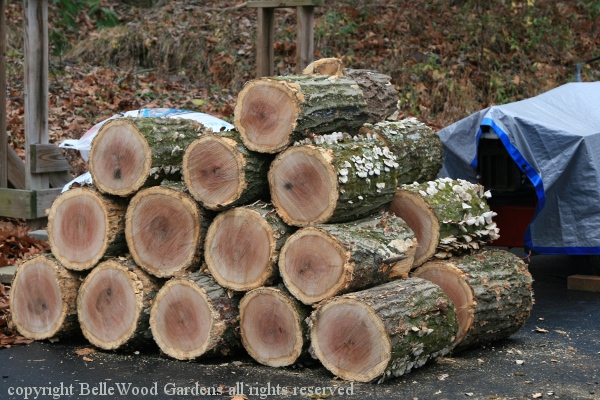
Paul had been cutting firewood while we were gallivanting about.
Back home again I fried up Bill's bacon, some home fried potatoes, and made a puffy omelet for the three of us, with local cider to drink. We three agreed that the bacon was pleasant but rather strongly flavored of smoke. I think I will use my piece for cooking, not for breakfast.
Monday, 14 December 2015
Yesterday I made a dry marinade of salt, crushed peppercorns, and finely slivered garlic, which I rubbed onto some pork, covered, and refrigerated, turning a few times.
Today I coarsely diced a piece of the bacon and browned the cubes. Set aside.
Browned the three meaty pieces of pork neck bones, more for the white bones than the meat. Set them aside.
Browned a rolled and tied pork royale roast (a boneless pork loin, 2 pounds in weight.) Set aside.
Diced several stalks of celery and 4 small leeks. Sauteed until beginning to color.
Returned the pork royale roast to the pot, with two of the neck bones on either side. Tossed the bacon cubes on top. Added a scanty cup of stock, covered with a heavy lid, and put the Le Creuset casserole into a 325 degree Fahrenheit oven.
The other meaty neck bone went into a different pot together with more celery, a cup of little de Puy lentils, and two cups of stock. Into the oven.
Back to Top
Back to December 2015
Back to the main Diary Page